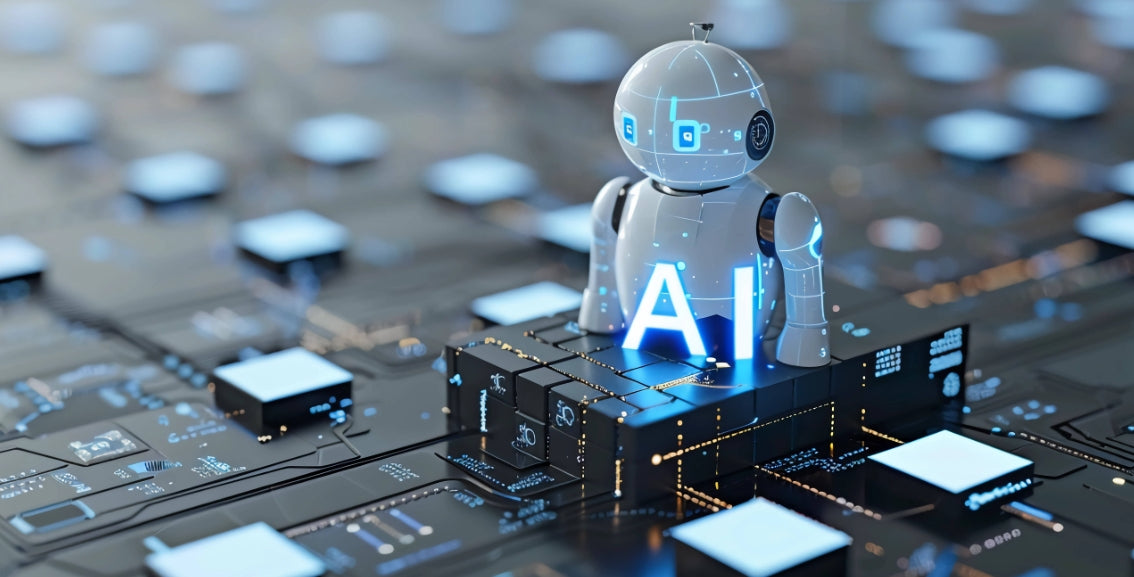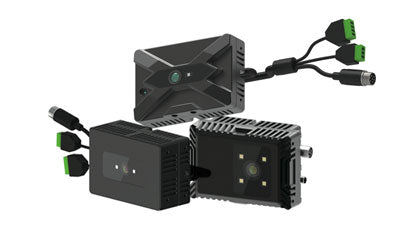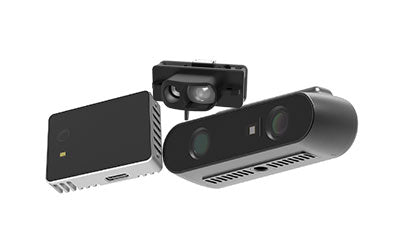The Role of TOF in the AIoT Era: The Depth-Sensing Eye of Edge Devices

In the era of AIoT (Artificial Intelligence of Things), the 'eyes' of the perception layer have become increasingly vital. Time-of-Flight (TOF) technology, with its high-precision 3D spatial sensing capabilities, is emerging as an indispensable depth sensor in edge devices. From smart lighting and intelligent elevators to unmanned convenience stores, TOF not only enhances system intelligence but also offers lightweight, low-power, and efficient sensing solutions for edge computing.
1. Understanding AIoT: The 'Perception–Decision–Execution' Loop in Intelligent IoT
AIoT is the deep integration of Artificial Intelligence (AI) and the Internet of Things (IoT). It emphasizes edge intelligence, allowing devices to independently perform recognition, analysis, and decision-making after collecting environmental data. Among these, sensing technology is especially critical—particularly 3D-capable sensors. TOF 3D cameras, as a representative of 3D sensing components, are increasingly integrated into smart edge devices.
Compared to traditional 2D image sensors, TOF captures scene depth information directly by measuring the flight time of light, making it ideal for challenging lighting conditions and non-contact environments. It’s a key component in RGBD camera systems or 3D depth cameras.
What is 3D ToF Laser Time-of-Flight?
3D ToF (Time-of-Flight) laser technology acquires three-dimensional information about objects by measuring the time it takes for light to travel from emission to return.
How it works:
A TOF system emits a beam of laser (or near-infrared) light onto the target. The reflected light is received by the sensor, which calculates the distance to the object based on the time the light took to make the round trip. By doing this simultaneously across multiple pixels, a complete 3D depth image can be generated in real time.
Key features of 3D ToF laser time-of-flight technology:
-
High-speed response: Captures depth images in real time, ideal for dynamic scenes.
-
High accuracy: Measures distances from a few millimeters to several or even tens of meters.
-
Active light source: Works effectively in dark or variable lighting environments, independent of ambient light.
2. Core Functions of TOF in Edge Perception Nodes
The deployment of TOF technology is accelerating the rise of "lightweight intelligent vision" at the edge. Key use cases include:
1. Distance Measurement and Object Detection
TOF sensors offer millimeter-level accuracy, low latency, and strong interference resistance—perfect for smart applications requiring real-time spatial awareness.
In automatic door sensors, TOF modules can precisely detect the distance and direction of approaching individuals or objects. Unlike traditional infrared sensors, TOF is unaffected by height or clothing, enabling more intelligent and energy-efficient door control.
In service and industrial robots, TOF continuously outputs 3D depth data, allowing for dynamic environmental perception and spatial reconstruction. Robots can detect obstacles, steps, or moving people in real time, assisting in autonomous navigation and operational safety.
Especially in automated warehouse logistics, AGVs (Automated Guided Vehicles) often rely on laser navigation (AGV laser navigation) for path planning. When TOF modules are added to the front, back, and sides of AGVs, they complement laser systems by covering blind spots and handling short-range, dynamic obstacles. This improves positioning accuracy in narrow or complex environments and enhances adaptability and efficiency when dealing with moving objects like people or stacked items.
As TOF chip prices drop and computational modules become more accessible, the technology is expected to see widespread adoption in low-cost, lightweight edge devices, from industrial automation to consumer electronics, upgrading perception intelligence across sectors.
2. People Counting and Behavior Recognition
In smart buildings and retail, TOF cameras—active 3D vision sensors—are gradually replacing traditional infrared beams, thermal imaging, or 2D cameras, becoming a mainstream solution for people counting and behavioral analysis.
TOF cameras emit modulated light and calculate return time to generate precise depth maps. Unlike RGB cameras, they function reliably in bright, dim, or no-light conditions. This makes them ideal for unmanned stores, smart office buildings, museums, and large supermarkets, where they accurately track entry/exit counts, dwell time, and movement paths—enabling real-time foot traffic analysis and heatmap generation.
Combined with edge AI computing, TOF systems can also identify fine-grained behaviors, such as queue formation, fall detection, or unaccompanied children. This supports building security, customer flow optimization, and emergency response. Unlike traditional cameras, TOF ensures higher privacy, since it captures depth images rather than RGB visuals, greatly reducing the risk of information leakage.
3. Spatial Understanding and Environmental Mapping
For spatial layout understanding and environmental mapping, TOF technology combined with edge AI computation plays a crucial role in enabling smart devices to perceive space and make autonomous decisions.
TOF cameras provide real-time 3D depth data, offering high-precision input for SLAM (Simultaneous Localization and Mapping) systems—especially useful in low-light, texture-less, or dynamically changing environments. Compared to RGB or LIDAR-based SLAM, TOF offers lower latency, greater stability, and easier integration, making it ideal for edge deployments.
In service robots, TOF helps detect indoor structures and avoid dynamic obstacles, supporting high-precision localization and path replanning. In warehouse AGVs, TOF can collaborate with inertial navigation and LIDAR to improve mapping speed and navigation robustness. In home security cameras and other low-power edge devices, TOF sensors enable dynamic background modeling and spatial anomaly detection for smarter home monitoring.
Paired with AI algorithms, TOF can also identify object boundaries, door/window openings, stair drops, and more—empowering scene segmentation and spatial understanding. This provides task-oriented insights for robots performing actions like delivery, cleaning, or inspection.
In short, the fusion of TOF and edge SLAM technology opens a new sensory dimension for smart terminals to 'understand the world.' It grants devices essential capabilities like map creation, spatial memory, and path optimization, making TOF a critical enabler of autonomous spatial perception in lightweight smart systems.
III. TOF + Low-Power AI Chip Solution: Achieving Efficient Perception at the Edge (Extended Version)
Traditional 3D vision systems often rely on GPUs, FPGAs, or cloud servers for data processing. This leads to high device power consumption, along with network latency, security concerns, and costly deployment. With the rise of edge computing and AI-dedicated chips, TOF-based vision systems are evolving toward on-device intelligence, enabling real-time sensing and computing capabilities directly at the edge.
1. Energy-Efficient Design: TOF's inherently low power consumption suits battery-powered devices
TOF modules feature highly integrated laser emitters and CMOS receiver arrays, offering compact size, low power consumption, and high stability. These advantages make them especially suitable for devices requiring long battery life.
For instance, Benewake’s TFmini Plus TOF sensor operates at a typical power consumption of only 85mW, making it widely applicable in drone obstacle avoidance, warehouse AGVs, robotic vacuum cleaners, and smart locks. Equipped with dTOF (direct Time-of-Flight) technology, which measures distance by directly timing laser pulse reflections, it eliminates the need for complex phase calculations. This not only ensures measurement accuracy (within 1 cm) but also greatly reduces algorithmic load and energy usage, making it ideal for embedded and battery-powered applications.
2. Lightweight Algorithms: On-device recognition powered by custom ML models
With the support of low-power AI chips (such as NPUs, DSPs, or RISC-V AI processors), TOF systems can locally run lightweight neural network models, enabling intelligent recognition without cloud dependence. These capabilities include:
-
Human detection and tracking: By extracting body contours from TOF depth data and combining it with ML models, the system can quickly identify and follow human movement.
-
Fall detection: By analyzing sudden displacements and height variations, the system can detect falls—especially in elderly care or safety monitoring—issuing real-time alerts without cloud upload.
-
Human pose estimation and gesture recognition: Useful for smart fitness mirrors, interactive gaming, and contactless HMI (Human-Machine Interaction), enhancing user experience.
These features protect user privacy by avoiding cloud transmission of sensitive images, while greatly reducing latency, making them ideal for latency-critical applications like industrial safety, medical monitoring, and smart access control.
The combination of TOF and low-power AI chips is becoming a pivotal solution for efficient vision perception at the edge, offering high accuracy, fast response, low power use, and privacy protection. This reflects a shift from the traditional 'data upload + cloud processing' model to a new paradigm of 'local computing + lightweight deployment.'
IV. Real-World Case Studies: How TOF is Transforming Traditional Applications
As a powerful 3D sensing technology, TOF (Time-of-Flight) is reshaping how traditional industries approach intelligent transformation. Compared to conventional 2D methods such as infrared or PIR sensors, TOF provides accurate spatial depth data and can be deeply integrated with AI algorithms to understand complex environments and behaviors. Here are several typical application scenarios:
1. Smart Lighting Systems: Instant activation and precise area detection
Conventional smart lighting relies primarily on PIR (Passive Infrared) sensors, which can only detect general movement without distinguishing human forms, distances, or trajectories—leading to false triggers or missed detections.
TOF sensors capture detailed spatial depth data, enabling more advanced sensing logic such as:
-
Zoned lighting control: In office buildings or subway stations, lighting can activate in stages based on proximity, balancing energy efficiency and user experience.
-
Human recognition and motion tracking: TOF distinguishes between actual human movement and other disturbances (e.g., curtains blowing or pets), enhancing accuracy and anti-interference capability.
-
Adaptive brightness by time or traffic: Lighting systems can adjust intensity and coverage based on real-time foot traffic, contributing to smarter and greener illumination.
2. Smart Elevators: Passenger behavior recognition and intelligent scheduling
Traditional elevator scheduling depends on button inputs or fixed time rules, lacking real-time awareness of human traffic, which can lead to empty runs and long wait times.
With TOF cameras, elevator systems can achieve:
-
Real-time detection of waiting passengers and queue behavior: Accurately count people waiting on each floor and detect queue formations to dynamically optimize dispatch strategies.
-
Passenger-type identification: Using 3D vision and AI models, elevators can identify individuals such as wheelchair users, seniors, or children—offering priority service or extended door times for better accessibility.
-
Safety monitoring and abnormal behavior detection: TOF can detect if someone is lingering in the doorway or has fallen, enabling real-time alerts or responsive behavioral adjustments.
This integration of perception + AI + control is driving elevator systems from passive operation toward proactive intelligence.
3. Unmanned Convenience Stores: Toward truly unattended operation
Conventional unmanned stores mainly rely on image recognition and RFID, which can suffer from errors due to occlusion, lighting variation, or complex human poses—impacting both user experience and security.
TOF technology introduces major enhancements in this context:
-
Customer tracking and behavior analysis: TOF tracks the full path of a customer from entry to exit, identifying behaviors such as lingering, picking, or hiding items. When fused with RGB imagery (creating RGB-D data), recognition accuracy improves significantly.
-
Smart shelf interaction detection: Without RFID, TOF detects hand movements near shelves or products, identifying pick-up or put-back actions and linking them to the payment system.
-
On-device analysis and privacy protection: All processing occurs locally on edge AI chips, with no full images uploaded, protecting user privacy and reducing latency.
By deeply integrating TOF with AI, unmanned retail moves closer to a truly fully sensed, fully automated, and zero-intervention intelligent operation model.
TOF technology is evolving from a supporting sensor to a core perception component. Its advantages in precision, low power, and 3D structural awareness make it a critical enabler for edge intelligence. As TOF modules become more affordable and AI edge chips more widespread, even more traditional applications will be transformed—accelerating the true digitalization of physical spaces.
5. Future Development Directions: Edge Computing + TOF
The integration of TOF (Time-of-Flight) technology with edge computing is rapidly accelerating the adoption of 3D perception systems. Looking ahead, several key trends are emerging:
-
High Precision, Lower Costs: Thanks to advancements in semiconductor technologies (Semiconductors 2024), the next generation of TOF camera sensors will offer higher resolution at a lower cost, making them viable for mid- to low-end devices in the 3D machine vision market.
-
Modular Integration: TOF sensors will be tightly integrated with AI processing units, giving rise to edge devices that combine TOF cameras, HMI (Human-Machine Interface), and AI analytics modules, enabling compact, all-in-one intelligent sensing systems.
-
Wider Application Scenarios: The TOF + AIoT solution will become a standard configuration in domains such as robotics, SLAM (Simultaneous Localization and Mapping), AGV navigation methods, automated material handling solutions, and infrared level detection.
-
Complementary to LiDAR: In certain use cases, TOF can work in tandem with 3D LiDAR sensors, forming a more robust and comprehensive 3D sensing network.
Conclusion: TOF – The 'Eyes' of the AIoT Sensing Revolution
As a cornerstone of 3D imaging technology, TOF is not only enhancing the perception capabilities of intelligent edge devices, but also providing a solid hardware foundation for cutting-edge fields such as 3D vision systems, AGV autonomous navigation, and SLAM-based robotic guidance.
Amid the rise of the AIoT era, TOF will continue to serve as the 'depth-sensing eyes' of smart devices—driving forward a new generation of perceptual intelligence and transforming the way machines understand and interact with the physical world.
Synexens 3D Of RGBD ToF Depth Sensor_CS30
Our professional technical team specializing in 3D camera ranging is ready to assist you at any time. Whether you encounter any issues with your TOF camera after purchase or need clarification on TOF technology, feel free to contact us anytime. We are committed to providing high-quality technical after-sales service and user experience, ensuring your peace of mind in both shopping and using our products.






